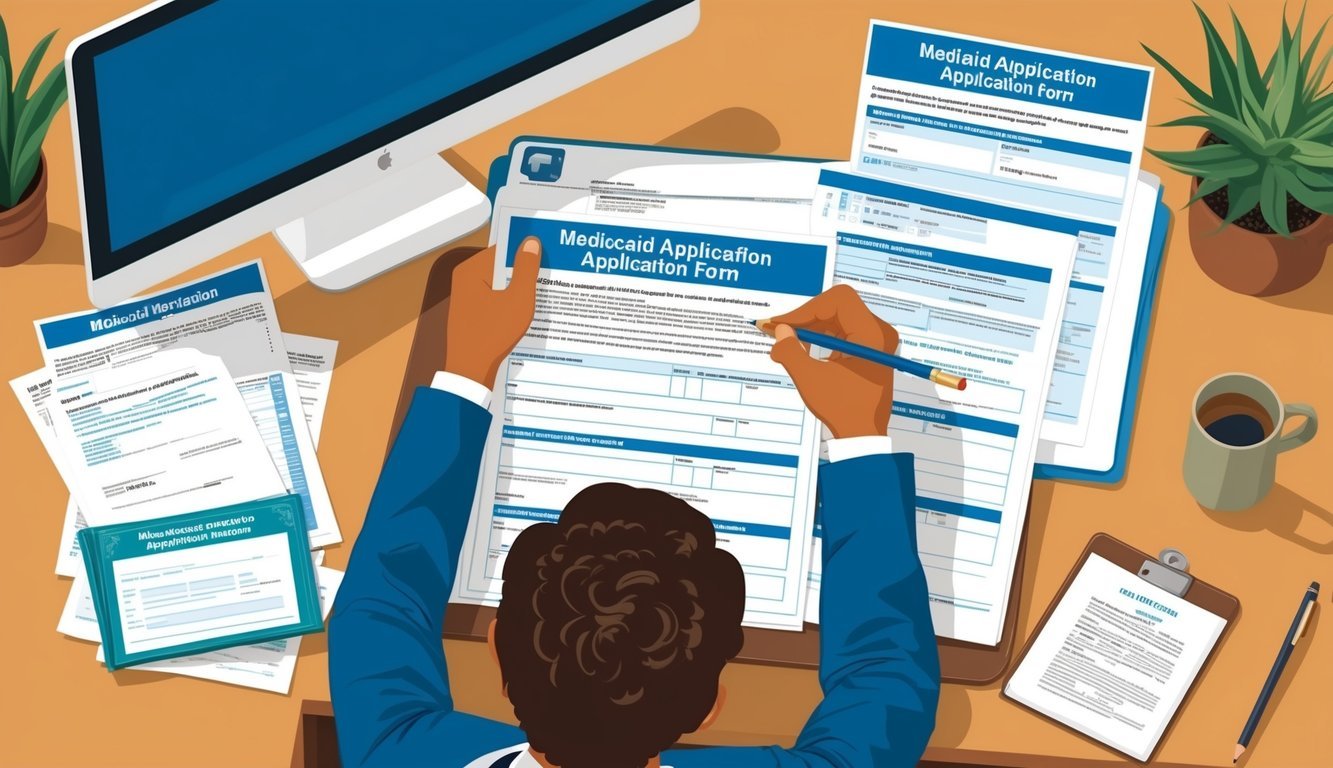“`xml
Signing up for Medicaid in Ohio might seem a bit intimidating, but trust me, it’s simpler than it looks.
You’ve got a few ways to jump in.
Whether you choose to apply online, by phone, in person, or by mail, pick the option that feels right for you.

You can apply for Ohio Medicaid online, by phone, in person, or by mail. Each method has its perks.
Online’s often the fastest—you can do it from the comfort of your couch.
But if you like to chat or ask questions in real time, the phone or in-person options are great.
Prefer old-school paper forms? Mail is the way to go.
Before you start, it’s a good idea to gather some important info.
You’ll need proof of income, your Social Security number, and details about your household.
Trust me, having these ready makes everything go smoother.
After you apply, the state will review your information and let you know if you qualify.
Key Takeaways
- You’ve got multiple options for applying for Ohio Medicaid, including online and by phone.
- Gather essential documents, such as proof of income, before diving into the application.
- After you submit your application, you’ll hear back about your eligibility and what comes next.
Eligibility and Enrollment
Getting on Medicaid in Ohio means meeting specific guidelines and following a straightforward process.
You’ll want to know what makes you eligible, how to fill out that application, and any key deadlines.
You can jump online at the Ohio Benefits website, give them a ring, or visit your local Department of Job and Family Services office.
Before you start, gathering necessary documents—like proof of income and residency—is super helpful.
If you’re curious about signing up for Medicare, check out the official Medicare website or reach out to a local agency for assistance.
Understanding Ohio Medicaid Eligibility
Wondering if you qualify? You might be eligible if you fit into certain groups—like kids, pregnant women, older folks, people with disabilities, or adults with low incomes.
Your income and household size make a big difference in whether you snag coverage.
Ohio did expand its Medicaid under the Affordable Care Act, which means many more adults can now get coverage.
If your income is up to 138% of the federal poverty level, you could be in!
Each group has its own guidelines.
For instance, kids can qualify with family incomes up to 206% of the poverty level, while pregnant women also have higher limits.
They might look at your assets too, especially if you’re applying for long-term care.
But for most programs, your assets usually aren’t considered.
How to Apply for Medicaid in Ohio
When it’s time to apply, you’ve got options galore! From online applications to phone calls, in-person visits, or good old mail, there’s a method for everyone.
For online applications, hit up the Ohio Benefits website or head to Healthcare.gov.
You can fill out and submit your application on the spot.
If you’re more comfortable talking to a person, give the Ohio Medicaid Consumer Hotline a call at 800-324-8680.
They’ll walk you through the phone application.
If you prefer the face-to-face experience, pop into your local County Department of Job and Family Services.
They’ll help you fill out the application and answer any questions you might have.
Want to go the mail route? You can grab an application form either from your county’s office or print one online, fill it out, and send it back to them.
Assistance with the Application Process
Navigating the Medicaid application can feel a bit overwhelming, but you don’t have to go it alone! There are folks out there who will help you for free.
Application assisters or navigators can guide you through the process.
They’ll help clarify any tricky terms and ensure you’ve got the right documents in hand.
Your local County Department of Job and Family Services is a fantastic resource—they can answer questions about eligibility and assist you with the application.
If you’re applying online, take advantage of the chat feature on the Ohio Benefits website for real-time questions.
For phone support, just call the Ohio Medicaid Consumer Hotline for guidance on the application process and eligibility inquiries.
Don’t hesitate to ask for help! It’s your right, and they want to make it easier for you.
Open Enrollment and Special Enrollment Periods
Unlike some health insurance programs, Medicaid doesn’t stick to an open enrollment schedule.
You can apply anytime throughout the year!
If you’re eligible, your coverage might kick in right away and sometimes even be backdated for up to three months if you had medical expenses then.
Renewing your Medicaid coverage every year is still a must, though.
The Ohio Department of Medicaid will keep you in the loop when it’s time to renew.
Special enrollment periods? Not a thing for Medicaid.
They’re meant for other types of health insurance.
But if your Medicaid eligibility changes, you might find yourself qualifying for special enrollment in another plan.
Keep in mind, any shift in your income or family situation can affect your eligibility.
It’s crucial to report those changes to avoid any hiccups.
Income Guidelines and Documentation
Your income plays a huge role in determining your eligibility for Medicaid.
Ohio uses Modified Adjusted Gross Income (MAGI) to assess whether you qualify.
For most adults, your income must be at or below 138% of the federal poverty level.
In 2024, that’s around $18,754 for a single person.
When you apply, you’ll need to show proof of income.
Think recent pay stubs, tax returns, or a letter from your employer.
If you’re freelancing or self-employed, a profit-and-loss statement might come in handy.
Other documents you might need include:
- Proof of Ohio residency
- Proof of citizenship or immigration status
- Social Security numbers for everyone applying
- Details about any other health insurance you might have
If you’re unsure about qualifying, go ahead and apply anyway—the worst they can say is no!
After Enrollment

Once you’re on board with Ohio Medicaid, there are a few key steps to follow.
This includes picking a health plan, managing your account, and keeping your information up to date.
Choosing a Health Plan and Provider
After signing up, you’ll need to select a health plan.
Check out the Ohio Benefits Self-Service Portal—you’ll find several options.
Take your time to compare them, especially looking at which doctors and hospitals are in-network.
Think about your unique health needs, too.
Next, you’ll want to choose a primary care provider, the go-to doc for most of your care.
Usually, you can find a list of chosen providers on your health plan’s site.
Look for one that’s convenient, and if you don’t make a choice, the plan might assign someone to you.
And hey, you can switch your plan or provider if your first pick doesn’t work out.
You aren’t locked in!\
Managing Your Medicaid Account
The Ohio Benefits Self-Service Portal is your home base for managing your Medicaid account.
It’s where you can check your coverage details and make necessary changes.
Need to print a temporary ID card? View covered services? Track claim statuses? You can do all that and more!
If the portal’s giving you headaches, reach out to Ohio Medicaid for help.
They’ve got people ready to assist.
And remember, keep your login details to yourself so that your private health info stays safe!
Reporting Changes to Your Situation
Life can change in a heartbeat, and when it does, you need to report it to Medicaid.
This is crucial! Changes in income, family size, or your address can impact your coverage.
Be sure to report big changes like:
- Getting a new job or losing one
- Welcoming a new baby
- Getting married or divorced
- Moving to a new place
You can report these updates online through the Ohio Benefits portal or reach out via phone or in-person at a local office.
Don’t wait too long—report changes as soon as they happen to avoid coverage gaps.
Long-Term Services and Supports
If you need ongoing care, Ohio Medicaid has Long-Term Services and Supports available.
This helps folks who struggle with daily tasks, like bathing or eating.
You might even be eligible for assistance at home or in a nursing facility.
For these services, you’ll need an assessment.
A nurse or social worker will check out your situation and create a care plan with you.
Some services you may qualify for include:
- Assistance with bathing and dressing
- Home-delivered meals
- Adult day care services
- Transportation to doctor’s appointments
These options can help you stay as independent as possible.
If you think you might need them, chat with your Medicaid case worker, and they can guide you through the next steps.
Frequently Asked Questions
Applying for Medicaid in Ohio might feel like a maze, but I promise, it’s manageable.
Let’s tackle some common questions to help you navigate the process more smoothly.
What’s the process to apply for Medicaid in Ohio if you’re an adult?
You’ve got options galore for applying for Ohio Medicaid.
You can jump in online, call, visit in person, or even send it by mail.
Most folks find the online route the easiest.
Pick whatever works best for you.
Remember, it’s all about finding your groove!
Can you check your Ohio Medicaid eligibility online, and how?
You bet! The Ohio Benefits Self-Service Portal is your best friend.
Create an account and answer some simple questions to see if you may qualify.
It’s kind of like peeking into a crystal ball, only way more accurate.
The portal gives you a solid idea of your eligibility.
What paperwork should you gather when applying for Medicaid in Ohio?
Get ready to dig a little! You’ll need proof of income (pay stubs or tax returns) and don’t forget your ID and Social Security card.
Think of it like a mini organization project—gathering those documents can help you reflect on your journey and make the process smoother.
What are the income limits to be eligible for Medicaid in Ohio this year?
Income limits can change, depending on the program and household size.
Generally, if your income is at or below 138% of the federal poverty level, you might be in the clear!
And remember, income comes in different shapes and sizes.
If you feel you might qualify, definitely check!
How do you get your hands on an Ohio Medicaid application form in PDF?
Scoring a PDF application form is easy—head to the Ohio Department of Medicaid website.
If you’re a fan of good old-fashioned paper, this is your time to shine.
There’s something satisfying about filling out a form by hand, right? Like leaving your mark on the world.
Typically, how long’s the wait for a response on your Medicaid application in Ohio?
The wait can feel like you’re stuck in quicksand, but usually, it’s around 30 days.
Sometimes it’s faster, sometimes a bit longer—it really depends on the specifics.
Think of it as a lesson in patience—an essential skill for this journey.
“`

